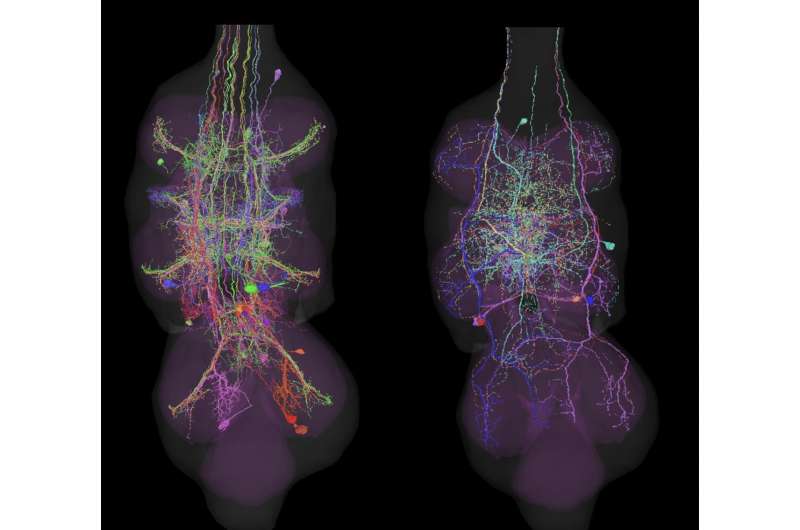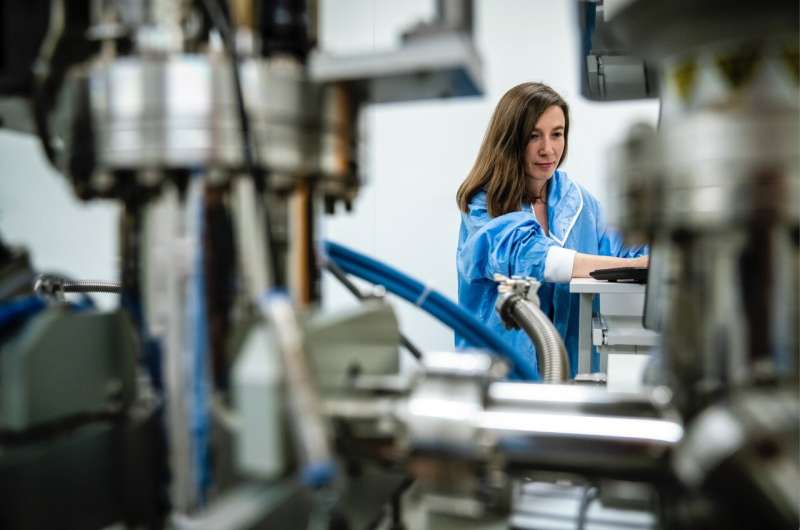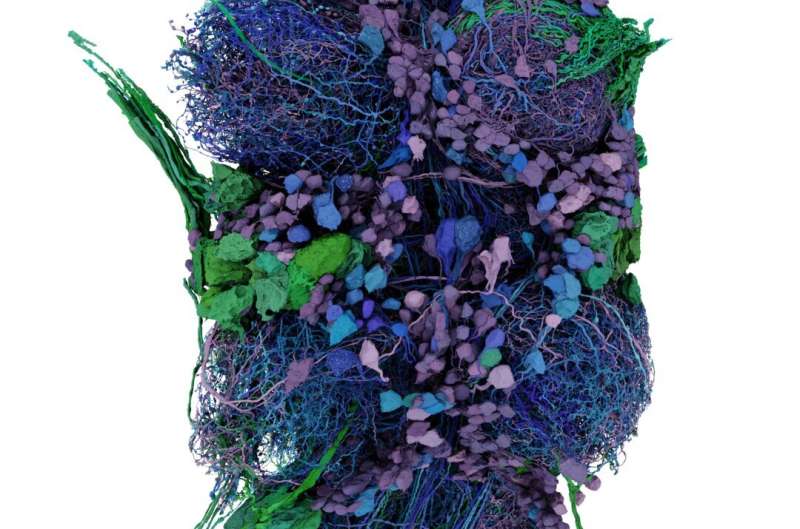This article has been reviewed according to Science X's editorial process and policies. Editors have highlighted the following attributes while ensuring the content's credibility:
fact-checked
peer-reviewed publication
trusted source
proofread
Researchers map Drosophila's neural networks that control wing and leg movement

Scientists at the University of Washington and Harvard Medical School, in collaboration with the ESRF, have discovered the neural circuits that coordinate leg and wing movements in the fruit fly (Drosophila). This could lead to a better understanding of how the nervous system senses and controls the body. The results are published in Nature.
One of the main functions of the neural system is to coordinate movements of the body. In order to understand how the brain controls adaptive motor behaviors, scientists have long been trying to decipher the neural circuit map down to the muscles.
Now researchers have connected the neurons from the fruit fly nerve cord, similar to the vertebrate spinal cord, with the muscles controlling the legs and wings. This sheds light on how the fly senses and controls movements of the legs and wings. While connectomes in small animals have been mapped before, it is the first time that scientists have found the synapse-level wiring diagram of motor circuits for a limbed animal.
Why the fruit fly? Drosophila melanogaster has a compact nervous system with sophisticated genetic tools and identified neurons with stereotyped function across individuals.
"They are marvelously skilled at motor control, including walking and flying, despite their tiny nervous system," explains John Tuthill, researcher at the University of Washington and corresponding author of the publication. Indeed, each of the flies' legs is controlled by only 70 motor neurons (compared to 600 in a cat's calf muscle), and each wing is controlled by only 29 motor neurons.

The fly has specialized muscles for power and steering in the wings. These wing muscles attach to different body parts: power muscles to the thorax and steering muscles to the wing hinge.
The team has now determined which pre-motor neurons in the fly's version of the spinal cord, known as ventral nerve cord (VNC), coordinate motor neurons controlling the leg and wing. To achieve this, they used several techniques: electron microscopy, sparse genetic labeling, and X-ray holographic nanotomography (XNH) at the ESRF.
Connectomics using X-rays
Electron microscopy showed the ventral nerve cord network, with 45 million synapses and 14,600 neuronal cell bodies. They paired this data with maps of leg and wing motor neurons using X-ray holographic nanotomography at the ESRF.
"Mapping motor neurons to their muscles with X-ray holographic nanotomography was essential to interpreting premotor network organization in the context of motor neurons function," says Wei-Chung Lee, principal investigator at Harvard University and one of the corresponding authors.
He adds, "ESRF ID16A is currently the only beamline in the world with the combination of imaging field-of-view and resolution to densely reconstruct neuronal wiring at such scales."

Over the last few years, the team, led by ESRF scientist Alexandra Pacureanu, has been developing X-ray holographic nanotomography at the ESRF to address the specific challenges posed by the connectomics field.
"Connectomics using X-rays is a very new field that emerged at the ESRF ... and today we have improved both spatial resolution and scalability of the technology to enable the study of meaningful neural circuits," she says. She adds, "The collaboration with neuroscientists has been crucial to leverage X-ray microscopy for pushing the frontiers of understanding how the nervous system functions."
Future work includes identifying differences in neuronal network wiring between individuals, sexes, over development, across species, and in response to injury or disease.
More information: John Tuthill, Connectomic reconstruction of a female Drosophila ventral nerve cord, Nature (2024). DOI: 10.1038/s41586-024-07389-x. www.nature.com/articles/s41586-024-07389-x
Journal information: Nature
Provided by European Synchrotron Radiation Facility





















